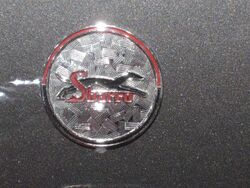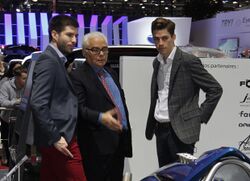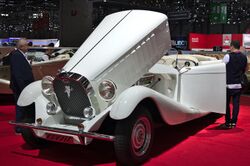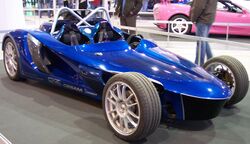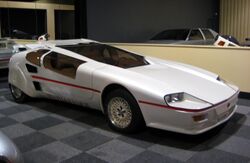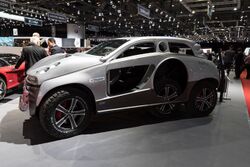Company:Sbarro (automobile)
Sbarro is a small Switzerland high-performance replica and sports car company founded by Franco Sbarro in 1971.
Models
The first Sbarro offered was a replica of the Lola T70, powered by a 5.4-litre Chevrolet V8. Since then, the company has produced small-series replicas of a variety of models including the BMW 328, Ford GT40, Bugatti Royale and Mercedes-Benz 540K.[1] While the majority of Sbarro's designs remained one-offs, about 135 examples of the BMW 328 Replica were built.[2] A few other models were built in smaller runs, usually in the single digits.
Some significant models have included the mid-engine Tiger (powered by a 6.3-liter Mercedes-Benz M100 V8),[3] the Stash (offered as a 2+2 coupé or convertible), and the extremely wedge-shaped Challenge of the mid-1980s. In the name of aerodynamics, the Challenge dispensed with traditional mirrors and may have been the first car sold with a reversing camera.[4] The original Challenge I, presented at the 1985 Geneva Auto Show, had a unique tubular frame and a turbocharged Mercedes-Benz 5-liter V8 engine. Claimed power was 380 PS (279 kW) and the top speed 310 km/h (193 mph).[5] Other special features were twin rear wheels and a biplane rear wing which angled upwards at up to 18 degrees under braking, to add downforce and stabilize the car. Sbarro also intended to provide each customer with a radio-controlled replica of the car.[5] The 1986 Challenge 2+2 was developed from this; it (and the succeeding Challenge III) had a planned production run of ten cars and used Porsche 930 underpinnings. There was also a "Baby Challenge" for children, presented in 1986. It was powered by a 350-cc, single-cylinder Honda engine.[6]
Sbarro also collaborated with Pierre Cardin for a mid-engined, turbocharged version of the Stash released in Paris 1975.[7] While the 109 kW (148 PS; 146 hp), 1.8-litre Volkswagen K70 engine provided impressive performance for the time, Cardin's special interior with its striping, special upholstery, and zip-fastened pockets was the main attraction.[8] All Sbarros have been extremely limited production vehicles - for instance, only five Stash seem to have been built, even though at least three engines, two bodystyles, and the Pierre Cardin special edition were on offer.[9]
Another series of project cars of the early 1980s sold to private customers are the Super Twelve and Super Eight. The 1982 Super Twelve had the bodywork of a squared-off hatchback, albeit with unusually broad fenders and many other hints at potency. The mid-mounted engine was a twelve-cylinder unit constructed from two Kawasaki Z1300 six-cylinder motorcycle engines.[10] The 1984 Super Eight featured largely the same bodywork, but received the marginally more sane eight-cylinder engine from the Ferrari 308.[10]
Sbarro has also built dozens of concept cars and custom high-performance vehicles for private customers. Some of the more recent concepts are the Christelle, Millennium Coupé, and Picasso (2001), GT12 (2000) and GT1 (1999). Some of these feature hubless wheels, a recurring Sbarro concept.[citation needed]
At the Geneva Motor Show on 3 March 2011, Sbarro unveiled the Evoluzione concept car. Sbarro's concept car had a 1.8-litre turbocharged four-cylinder engine from Audi. It output 134 kW of power. The Evoluzione was built without normal production car constraints, as the rear exposes the entire rear suspension set-up as well as the engine. Overall, the design took 25 students just 13 weeks to complete.[citation needed]
Espera
Established over 20 years ago by Franco Sbarro, Sbarro Espera school offers training in car design and mechanics, and combines theory and practice.[11]
References
- ↑ Lawrence, Mike (1996) (in en). A to Z of Sports Cars, 1945-1990. Bay View Books. ISBN 9781870979818. https://books.google.com/books?id=glKW-Kh-lmcC&q=sbarro+&pg=RA1-PT218.
- ↑ Sihvonen, Jukka (1985-03-19). "Franco Sbarro ylittää itsensä" (in fi). Tekniikan Maailma (Helsinki: TM-Julkaisu) 41 (5/85): 28. ISSN 0355-4287.
- ↑ "Sbarro Tiger, 1973". http://sbarro.phcalvet.fr/voitures/tiger/tigergb.html.
- ↑ "Sbarro Challenge I". Louwman Museum. Archived from the original on 2014-10-14. https://web.archive.org/web/20141014122219/https://www.louwmanmuseum.nl/en/Ontdekken/Ontdek-de-collectie/sbarro-challenge-i.
- ↑ 5.0 5.1 Sihvonen, p. 29
- ↑ Calvet, Philippe. "Sbarro Challenge Baby, 1986". Franco Sbarro: L'autre façon de concevoir l'automobile. Archived from the original on 2019-04-07. https://web.archive.org/web/20190407030742/http://sbarro.phcalvet.fr/voitures/Challenge_baby/Sbarro_Challenge_baby.html.
- ↑ Armstrong, Douglas (December 1975). "International Exchange". SA Motor (Cape Town, South Africa: Scott Publications): 16.
- ↑ Armstrong, p. 19
- ↑ Calvet, Philippe. "Sbarro Stash, 1974". Franco Sbarro: Another vision of car. http://sbarro.phcalvet.fr/voitures/Stash/stashgb.html. Retrieved 2016-04-28.
- ↑ 10.0 10.1 Mazzocchi, Gianni, ed (April 1984). "Autonotizie: Per lo Svizzero Sbarro questa è una ≪Ferrari≫!" (in Italian). Quattroruote (Milan, Italy: Editoriale Domus) 29 (342): 102.
- ↑ "Formation en design automobile et mécanique". e-sbarro.fr. Archived from the original on 2012-06-21. https://web.archive.org/web/20120621173457/http://www.e-sbarro.fr/index.php/l-ecole/espera-sbarro.html. Retrieved 2012-06-06.
- Lawrence, Mike, A to Z of Sports Cars. Bideford: Bay View Books, 1991. ISBN:1-870979-81-8
External links
 |
